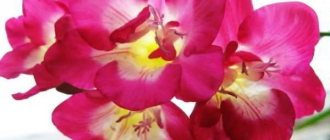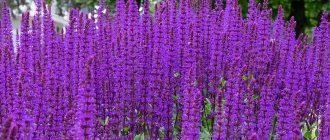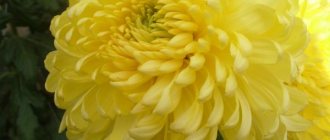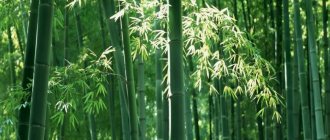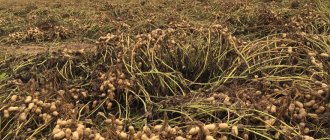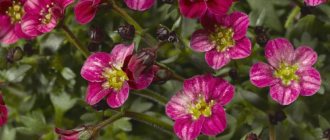Articles / Plants /
Rhododendrons are rightly considered difficult to grow in agricultural technology. Your humble servant knows this firsthand. If you treat a rhododendron according to the rule - “plant it and forget it”, that is, take it like a little boy into the forest and leave it to be devoured by the wolves, then nothing good will happen to it. There are no indestructible rhododendrons - this is a fact. But the same fact is that in natural conditions not a single tree has a guarantee of survival.
However, among rhododendrons there are their “iron men” (steel men), with outstanding adaptability. One of them is yellow rhododendron. My story about it is based on the experience of growing it in our country garden and its surroundings.
Detailed description
Interestingly, this flower is also called “Yellow Stupefy” because the aroma of the flowers is too strong. Azalea Pontica grows quickly, branches strongly, and has good resistance to various diseases. But it does not tolerate dry air well.
- The leaves are elongated, dark green, ciliated along the edges. Young leaves are pubescent, but over time this down disappears.
- The flowers are large, yellow (can be pink or purple), smell very strong (simply intoxicating). The petals are fused only at the bottom, slightly curved, collected in 10-12 pieces in umbrella inflorescences.
- The fruit is a cylindrical seed capsule.
- Roots - the root system is superficial.
Subvarieties and their photos
Rhododendron Pontica has many different hybrid varieties, let's look at the most famous and popular among them.
Cecil
A spreading bush with soft pink flowers, the crown of the flower is formed in a semicircle.
Coccinea speciosa
A clearly vertical bush with bright orange flowers and a lush crown.
Nancy Waterer
A plant with large yellow flowers of an unusual shape, all petals have a wavy, slightly corrugated edge.
We have prepared interesting articles for you in which you will find descriptions and photos of other types and varieties of rhododendron. See what Zolotisty, Yakushemansky, Rasputin, Daursky, Cunninghams White, Pjm elite and Crystal Baby, Caucasian, Polarnakht, The Hague and Nova Zembla look like.
Features of biology
Lifespan:
up to 100 (in culture up to 50) years.
Annual growth of shoots:
5...8 cm.
Lighting requirements:
photophilous.
Soil requirements:
prefers gravelly, thin soils with a neutral or slightly acidic reaction.
Winter hardiness:
high. In the conditions of Moscow and the Moscow region, it winters without shelter.
The plant is poisonous:
all parts contain rhodotoxin. Yellow rhododendron honey is also poisonous, but the concentration of poison in it is low and it does not pose a mortal danger. Symptoms of poisoning are weakness, dizziness, severe sweating, vomiting, and in severe poisoning, convulsions.
Bloom
When and how does this happen?
Flowering occurs in winter and spring and can last from one to two months. The flowers are collected in spectacular inflorescences of 12 pieces. During flowering, the bush is almost completely covered with flowers; no leaves are visible.
Care before and after
The most important thing is to create conditions that promote, and not hinder, the development of the plant. Before flowering, Azalea Pontica needs moist air, moderately moist soil, and good lighting. After flowering, the bush needs pruning and shaping.
Attention! Monitor watering; the soil should not dry out.
What to do if it doesn't bloom?
Maybe you shaded the plant too much and it needs light. It is worth rearranging it closer to the light or providing additional illumination with a phytolamp. Another reason may be dry air - be sure to humidify the air.
He was the first.
Rhododendron yellow (synonym Azalea pontica) was introduced into cultivation in 1792 in England. This marked the beginning of the hybridization of rhododendrons. There is no doubt that the Pontica hybrids are the oldest group of cultivated azaleas. Subsequently, the center of hybridization moved to Belgium, where most of the “Pontic azalea” hybrids come from.
Walter Schmalscheidt, Germany.
"History of hybridization of deciduous azaleas in Western Europe."
The chronology of cultivated rhododendron is fragmentary and unreliable. Who, when and where came to the gardens of Europeans first, and who came second and third, we know only approximately. But the fact that the yellow azalea was among the first is certain. It could not be otherwise, because this species is an original European resident, and not an alien from America or Asia, like most others. And for sure, the inhabitants of the Carpathians and Caucasian foothills long ago transferred this shrub from the mountain slopes to their front gardens. But even if you count from the “first mention in the chronicles,” yellow rhododendron is still a little ahead of the others.
This rhododendron does not claim to be the brightest and most spectacular. But it has one very significant advantage over other types. In the Center of Russia, he is one of the few who can be left for another year without any care. Generally speaking, in Russia p. yellow can be grown almost everywhere where there is gardening: throughout the European part, in the Urals, in the south of Siberia and in the Far East. It feels worst in the arid steppe regions (Astrakhan, Volgograd, Saratov, Republic of Kalmykia). And you shouldn’t mess with it at all where severe winter frosts are combined with little snow (Transbaikalia). Black currant can serve as a signal crop for the possibility of growing it. Where it is able to bear fruit, it is worth trying yellow rhododendron.
Step-by-step care instructions
Choice of location - grows well on a sunny windowsill, but can tolerate some partial shade. It is very useful to place an aquarium next to the plant.- What the soil should be like - it should be nutritious, but light and loose, acidic or slightly acidic in composition. The most convenient way, of course, is to purchase the substrate in the store. You can also add a little perlite to it.
- Planting - it is best to plant in the spring, but, in principle, it is possible at any other time, just without disturbing the earthen ball. It’s better to take a ceramic pot and don’t forget about the obligatory layer of drainage first. On top, after planting, you can cover the soil with dried coconut fiber or moss.
- Temperature - it’s great if the plant is provided with a temperature “corridor” of 10 to 18 degrees Celsius. In hot weather, you can achieve the desired temperature using an air conditioner.
- Watering - good watering is needed, the plant is demanding of soil moisture, but cannot tolerate stagnant water. Therefore, the guideline should be the drying of the top layer of soil - as soon as it begins to dry out slightly, water it. The water must be soft, you can settle it, you can use a filter.
- Fertilizing - you need to fertilize Azaleas once a week (or every two weeks), it is best to use specially prepared fertilizer “For Azaleas” for this, prepare the solution strictly according to the instructions, an overdose can greatly harm the root system.
- Pruning - pruning should take place after flowering; you can shorten all branches by about 1/3 or do selective pruning by choosing a specific shape. You also need to periodically remove faded flowers during flowering so that they do not weaken the plant. During the summer, we pinch out new young branches, leaving 4 or 5 leaves on each, the crown will become more lush.
- Transplantation - of course, it is worth replanting in the spring or, at most, in September. It is better not to destroy the lump of earth when replanting (unless treatment of the root system is required in the case of the presence of any pests). Young plants require replanting every year, and adults every 3 years.
- How to prepare for winter - starting from October, you need to provide Azaleas with a temperature within 10 degrees for the correct formation of flower buds. From January the temperature should be slightly higher (about 15 - 16 degrees) to stimulate flowering.
Agricultural technology.
Rhododendron yellow is naturally highly adaptable. In the foothills of the Caucasus, it usually settles on poor dry soils, along forest edges and clearings. In Turkey, it can be found on rocky mountain slopes at altitudes of 500-2500 meters. In the Carpathians and Alps, it grows in mixed mountain forests, not only along the edges, but also under a sparse canopy.
Landing place. The soil. Yellow rhododendron is sun-loving and relatively drought-resistant. Even in the south, where insolation is relatively high, it usually prefers open locations. As for central Russia, here the bush is shown open sun. It can grow in the shade, but this reduces the vitality of the plant. The proximity of groundwater is also undesirable, and spring flooding with melt water is unacceptable.
The soil is sandy loam or light loamy, with a slightly acidic or neutral reaction pH = 5.0-6.5. The soil mixture can be made up of turf soil, peat and sand in a ratio of 1:2:1.
Other options:
Heather soil, peat, sand 2:1:1.
Leaf soil, peat, sand 1:2:1.
Considering the shrub’s ability to spread widely, the planting site is formed shallow, but wide enough: depth 25-30cm, diameter 2-2.5m.
How to propagate?
Azalea Pontica propagates well from cuttings and seeds.
Cuttings
This method allows you to preserve all the varietal characteristics of the flower.
- Cuttings are cut after flowering, approximately 6 - 8 cm long.
- Then you need to dip them in a weak solution of potassium permanganate and immerse them in light soil.
- After about 2 months (if kept under film and at a temperature of 25 degrees), roots will appear; now they can be transplanted into a large box with pine soil and peat and kept there for about two more months.
Seeds
- In the spring you need to sow the seeds in a prepared mixture of sand and peat on the surface.
- Water on top (spray from a spray bottle) and lightly sprinkle with clean sand.
- After 3 - 4 weeks (if kept in greenhouse conditions) shoots will appear.
- You will need to pick them twice - in June and in March; around May you can plant them in separate pots.
Just so you know.
Yellow rhododendron (Rhododendron luteum Sweet.) is a deciduous shrub 1-1.5 m high (in nature up to 4 m), and a wide crown up to 2.5-3 m (maximum up to 6 m). Like most rhododendrons, this species is not found on the plains, but gravitates to the mountains and foothills. It settles at altitudes up to 2500m, often rising above the forest line.
The flowers are funnel-shaped and bell-shaped, 4-6 cm in diameter, the petals are golden yellow, deep yellow or light orange, in shapeless inflorescences of 7-12 pieces. It blooms in May after the first wave of flowering of rhododendrons (Daurian, Canadian, Sikhotinsky, Ledebura, etc.) and blooms for 2-3 weeks, ending flowering in the first ten days of June.
The first name of the yellow rhododendron was Pontian azalea (Azalea pontica L.). Pontic - from the word Pont. The ancient Greeks called the Black Sea Pontus Aksinsky, that is, the Hospitable Sea, or simply Pontus. Pontic, accordingly, meant Black Sea.
But the name Pontic azalea did not stick to this species. Including because the species’ range is much wider than just the Black Sea region. In addition to the Caucasus and Asia Minor, yellow rhododendron also grows in the Carpathians (Ukraine, Poland, Belarus) and in the Alps. While the epithet Pontic was applied only to the southwestern (Turkish) shores.
In addition, there is another rhododendron of a similar name, the Pontic rhododendron (Rhododendron ponticum) , which, as it turns out, has more rights to this specific epithet. They have practically nothing in common, except that they are both beautiful flowering shrubs. Pontian rhododendron is a shrub, 150-250cm (maximum up to 6m) in height, with fairly large evergreen leaves and lilac flowers. Its homeland is the Caucasus, Transcaucasia, Asia Minor, the Balkans, Syria, Lebanon. It is interesting that the ranges of these shrubs overlap precisely in the area that the ancient Greeks called Pontic.
Diseases and pests
Diseases - most often, Azalea Pontica can develop chlorosis, root rot, leaf spot, and rust. Treatment with copper oxychloride, Bordeaux mixture and Fundazol will help.- Pests are the “main enemies” here: spider mites and rhododendron bugs. As a preventative measure, you should periodically wash the plant under a warm shower, because these pests appear only due to dry air. You can get rid of them using “Aktara” or “Aktellika”.
Conditions for growing yellow rhododendron
Yellow rhododendron is suitable for growing in the middle zone, the North-West, the Urals, Western Siberia, and the Far East. The shrub tolerates winters well under cover. For planting, choose frost-resistant varieties that can withstand even difficult climates.
Ideal conditions for growing yellow rhododendron:
- sunny place or partial shade;
- regular supply of moisture to the soil;
- high soil fertility;
- air humidity;
- shelter for the winter.
Deciduous yellow rhododendron is used in single and group plantings. The plant becomes the central part of the composition. It looks especially impressive next to other deciduous rhododendrons, against the backdrop of lawns and evergreen trees.
The culture is sensitive to lack of moisture. Therefore, during the growing season, watering must be organized, while avoiding stagnation of water. The duration of flowering is affected by the fertility of the soil. Before planting, the soil composition is improved by adding humus and peat.
Prevention of various problems
To prevent any problems from plaguing the beautiful Azalea, you need to properly organize her maintenance and take proper care of her. And to do this you just need to follow the rules of care.
Azalea Pontica pleasantly stands out among all the others due to its ease of care and unpretentiousness. This species can withstand high temperatures and can do without fertilizing for some time. And how much bright beauty it gives when it blooms! Its sunlight charges with energy of joy and vigor. Let this plant be one of the first planted on your windowsill and it will give a powerful incentive to decorate your entire apartment with beautiful flowers.
If you find an error, please select a piece of text and press Ctrl+Enter.
What is the difference from other types of Rhododendron
Garden azalea - planting and care in open ground
It is known that all representatives of the Rhododendron genus grow exclusively on acidic soils. The correct composition of the soil affects the flowering and viability of the plant as a whole. But this does not apply to the Pontic azalea. It is grown in almost any soil, even the poorest, which does not affect its appearance.
Note ! You should not plant Pontic azalea in very dry steppe regions, such as Kalmykia, Saratov, Volgograd and Astrakhan regions. Severe winters, such as in Transbaikalia, are also not suitable for the bush.
Another important distinguishing feature of the plant is its ability to reproduce by root shoots, while other species reproduce by cuttings or layering.
An important feature of the species is its toxicity. The substance andromedotoxin, which is dangerous for all living beings, is contained both in the above-ground parts and in the roots.


